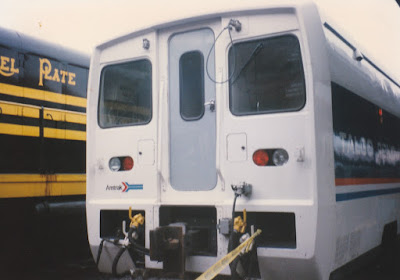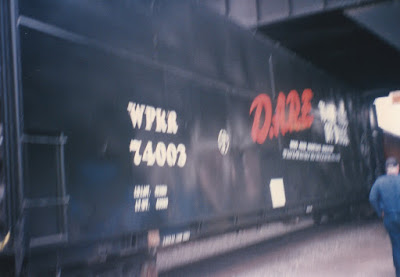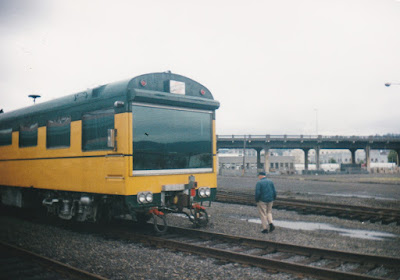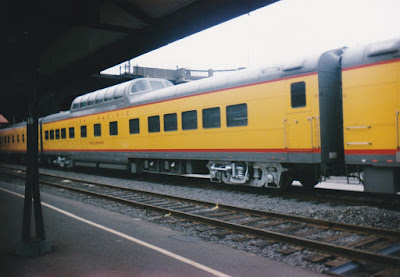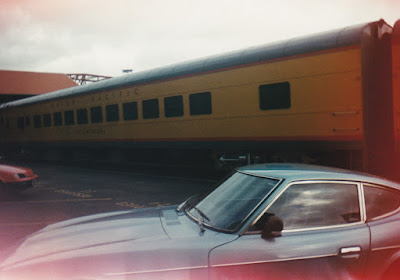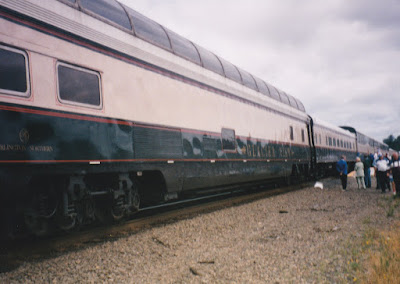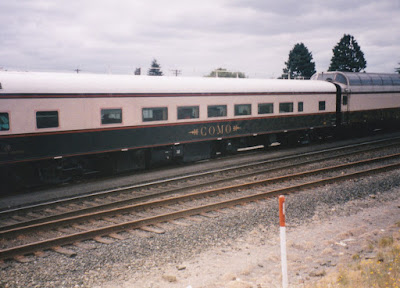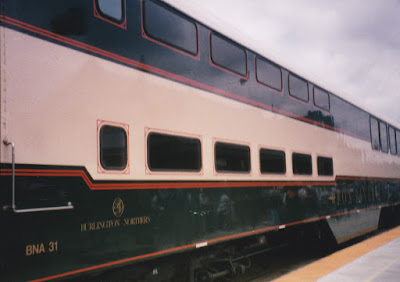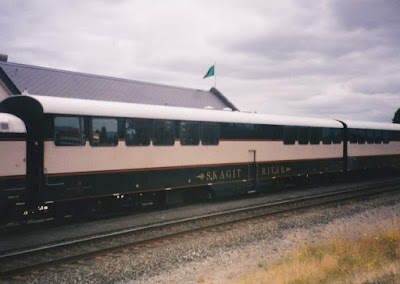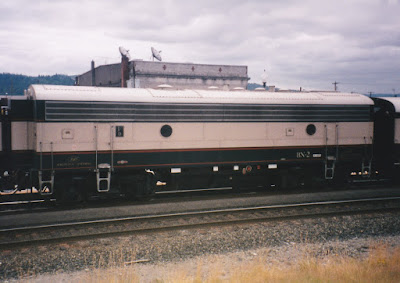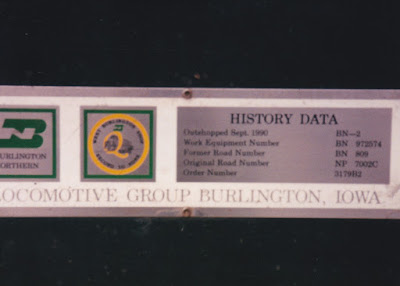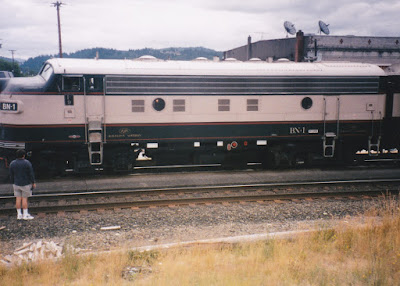Tuesday, April 17, 2018
Amtrak Talgo Pendular 200 at the Portland Union Station Centennial
Displayed at the 100th Anniversary of Union Station in Portland, Oregon, on May 11, 1996, this Spanish-built Amtrak Talgo Pendular 200 Demonstrator trainset was used between Portland and Seattle. It was the prototype of the Cascades trainsets that would eventually go into service.
Willamette & Pacific Woodchip Car #74003 at the Portland Union Station Centennial
Displayed at the 100th Anniversary of Union Station in Portland, Oregon, on May 11, 1996, Willamette & Pacific Railroad #74003 is a woodchip gondola that wears a special paint scheme for D.A.R.E., Drug Abuse Resistance Education. It was originally built in 1974 for the Southern Pacific Railroad as #355220.
DLMX Nickel Plate Road RSD-5 #324 at the Portland Union Station Centennial
Displayed at the 100th Anniversary of Union Station in Portland, Oregon, on May 11, 1996, this Alco RSD-5 was built in November 1955 as Utah Railway #306. It was retired in May, 1982. It was sold to Industrial Salvage & Metals of Salt Lake City in November 1983 and was traded to the Promontory Chapter of the NRHS in January 1984. Doyle McCormack purchased it in October 1993 and painted it as Nickel Plate Road #324, though it actually carries the DLMX reporting mark. Nickel Plate didn't actually have any RSD-5s, but they did have the similar 4-axle RS-3s. The number 324 was an unused number on the Nickel Plate roster, between the road's Baldwin AS-16s and Alco RSD-12s.
BKSX Dome Coach #9410 at the Portland Union Station Centennial
Displayed at the 100th Anniversary of Union Station in Portland, Oregon, on May 11, 1996, BKSX Dome Coach #9410 was built by the Budd Company in 1955 as Great Northern #1331 for the Empire Builder. It was assigned Burlington Northern #4611, but never received it before becoming Amtrak #9471. It was renumbered #9410 in January 1984 when it was converted to Head-End Power. It was retired in 1995 and sold to become a RailVentures/Montana Daylight car.
BKSX Dome Coach #9407 at the Portland Union Station Centennial
Displayed at the 100th Anniversary of Union Station in Portland, Oregon, on May 11, 1996, BKSX Dome Coach #9407 was built by the Budd Company in July 1954 as Northern Pacific #550 for the Vista Dome North Coast Limited. It was assigned Burlington Northern #4617, but never received it before becoming Amtrak #9477. It was renumbered #9407 in October 1983 when it was converted to Head-End Power. It was sold to become a RailVentures/Montana Daylight car, receiving BKSX reporting marks in May 1995, though at this point in 1996 it still gives the appearance of an Amtrak car.
BKSX Coach #4001 at the Portland Union Station Centennial
Displayed at the 100th Anniversary of Union Station in Portland, Oregon, on May 11, 1996, BKSX Coach #4001 was built by the Budd Company in 1950 as Southern Pacific 44-Seat Coach #2367 for the Sunset Limited. In 1951 it was renumbered to Texas & New Orleans #440, and in 1961 it was renumbered to SP #2228. It later became Amtrak #4415. In 1980, Amtrak rebuilt it as a 40-seat ADA Coach with Head-End Power and it became Amtrak #4001. It was retired by Amtrak in 1995. At this point it was being operated as a RailVentures/Montana Daylight car.
BKSX Dome Coach #9544 "Silver Scene" at the Portland Union Station Centennial
Displayed at the 100th Anniversary of Union Station in Portland, Oregon, on May 11, 1996, Dome Coach Silver Scene was built by the Budd Company in 1947 as Chicago, Burlington & Quincy #4729 for the Twin Cities Zephyr. It became Burlington Northern #5484 and then Amtrak #9544. It was retired in December 1983 and passed through a series of owners, by this time being restored with a California Zephyr letterboard (though this was not a California Zephyr car) and being operated as a RailVentures/Montana Daylight car.
Union Pacific DDA40X #6936 at the Portland Union Station Centennial
Displayed at the 100th Anniversary of Union Station in Portland, Oregon, on May 11, 1996, Union Pacific #6936 is a DDA40X, built by the Electro-Motive Division of General Motors in January 1971, one of 47 built, all for the Union Pacific, which at nearly 100 feet in length and with 6,600 horsepower are the largest and most powerful diesel locomotives ever built. #6936 is one of 13 that survive today, and the only one still owned by Union Pacific. It was transferred from freight to excursion service in May, 1985.
Burlington Northern GP39E #2750 at the Portland Union Station Centennial
During the 100th Anniversary Celebration of Union Station in Portland, Oregon, on May 11, 1996, this freight train passed through. Burlington Northern #2750 was originally built by the Electro-Motive Division of General Motors in April 1963 as Great Northern Railway GP30 #3007. After the Great Northern was merged into Burlington Northern in 1970, it became Burlington Northern #2207. In April 1989 it was rebuilt by the Electro-Motive Division of General Motors into GP39E #2750. This was the first GP39E to be completed.
SP #4449 & SP&S #700 at the Portland Union Station Centennial
At the 100th Anniversary of Union Station in Portland, Oregon, on May 11, 1996, Portland's two operating mainline steam locomotives, Southern Pacific #4449 and Spokane, Portland & Seattle #700, were displayed side-by-side. Both are 4-8-4-type locomotives. #4449 is a GS-4 class locomotive, built by the Lima Locomotive Works in 1941 for glamorous service pulling Southern Pacific's premier Daylight streamlined passenger trains in Southern California. It was replaced by diesels and retired on October 2, 1957. #700 in one of three 4-8-4s built for the SP&S in 1938 by the Baldwin Locomotive Works of Philadelphia, Pennsylvania. These locomotives were identical to A-3 class locomotives then being delivered to SP&S's parent, the Northern Pacific Railway, except that the SP&S locomotives burned oil instead of coal. By 1955, the SP&S had completed dieselization and was ready to retire the last of its steam locomotives. After pulling 1,400 passengers on a 21-car Farewell to Steam Excursion between Portland and Wishram, Washington on May 20, 1956, #700 joined the rest of SP&S's steam locomotives in a scrap line. After the Union Pacific offered the City of Portland 4-6-2 Pacific #3203 to display in a park, SP&S donated #700 on January 13, 1958, and would be the only SP&S or NP Northern to survive; in fact only one other SP&S steam locomotive survived. Southern Pacific donated #4449 to the City of Portland on April 24, 1958. All three locomotives were put on static display at Oaks Amusement Park. On December 14, 1974, #4449 was removed from Oaks Park and moved to Burlington Northern's Hoyt Street Roundhouse near Union Station for restoration to pull the American Freedom Train, a museum train of American artifacts that traveled the country in celebration of the Bicentennial in 1976. #4449's boiler was put to steam on April 18, 1975 for the first time since 1957. She moved under her own power on April 21, and was christened on May 16. She left Portland on June 20 to take over the Freedom Train in Chicago on August 4. #4449 pulled the Freedom Train for the rest of its tour until it ended in Miami on December 31, 1976. #4449 returned to Portland by pulling a series of "Amtrak Transcontinental Steam Excursions" across the South and West in April, 1977, still in its Freedom Train paint but with the "Amtrak" name added to the tender. #4449 arrived in Portland on May 1, having visited at least 30 states (many more than once) during its Freedom Train and Amtrak Excursion travels, and was placed in indoor storage. In 1981, #4449 emerged, restored to the post-WWII version of its Daylight paint. After #4449's restoration, 15-year-old Chris McLarney founded the Pacific Railroad Preservation Association in 1977 to restore #700. The locomotive returned to operation in 1990.
Amtrak B40-8P #802 at the Portland Union Station Centennial
At the 100th Anniversary of Union Station in Portland, Oregon, on May 11, 1996, Amtrak had a Superliner consist on display for visitors to walk through. Dash 8-40BP (or B40-8P) #802 was on display with the consist. Amtrak #802 was built by General Electric in 1993, one of the first of Amtrak's newest generation of locomotives.
Willamette & Pacific GP39-2 #2304 "Corvallis" at the Portland Union Station Centennial
Displayed at the 100th Anniversary of Union Station in Portland, Oregon, on May 11, 1996, Willamette & Pacific #2304, Corvallis, is a 2,300-horsepower GP39-2 that was built by the Electro-Motive Division of General Motors in 1974 as Atchison, Topeka & Santa Fe #3603. It is one of a group of 17 GP39-2s Willamette & Pacific acquired from the Santa Fe in 1993.
Portland Traction Company SW1 #100 at the Portland Union Station Centennial
Displayed at the 100th Anniversary of Union Station in Portland, Oregon, on May 11, 1996, locomotive #100 is a 600-horsepower SW1 built by the Electro-Motive Division of General Motors in February 1952. It was originally owned by the Portland Railroad & Terminal Division of the Portland Traction Company and has worked on the East Portland branch for nearly its entire existence. It was joined in March 1953 by another SW1: #200. In the mid-1980s, #100 was sold to Watco Companies and used at a paper mill in Wallula, Washington, while #200 was sold and ended up serving a grain elevator in Superior, WI. #100 was purchased by Dick Samuels in 1987 for use on its original line, which would become the East Portland Traction Company, and was repainted back to its original orange paint scheme, which it retains today. #100 was also used for a time on the Molalla Western in 1993 just after Dick Samuels took over that line, but is typically used on the East Portland line and calls the Milwaukie shops home.
Great Northern Caboose X40 at the Portland Union Station Centennial
Great Northern Caboose X40 was displayed at the 100th Anniversary of Union Station in Portland, Oregon, on May 11, 1996. It built in 1960 by the International Car Company. It became Burlington Northern #10330. It was retired in the 1980s and was purchased by private owners and restored to Great Northern colors.
Sumpter Valley Railway 2-8-2 #19 at the Portland Union Station Centennial
Sumpter Valley Railway #19 is the first of a pair of narrow-gauge 2-8-2 Mikados built for the eastern Oregon railroad by the American Locomotive Company in 1920. #19 & #20 were replaced on the Sumpter Valley in 1940 by a pair of used Baldwin articulated 2-6-6-2 Mallets. The tenders from the Mikados were put behind the Mallets, and the Mikados were sold to Alaska's White Pass & Yukon, where they served until 1957. The Mallets were sold to a railroad in Guatemala in 1947, and the tenders went with them. The Sumpter Valley reacquired the two Mikados in the 1970s and got the tenders back from Guatemala.
#19 was restored at the Brooklyn Roundhouse in Portland, Oregon, in the early 1990s. It had recently been completed and was brought to Union Station's 100th Anniversary on May 11, 1996, before being returned to the Sumpter Valley. A section of track at Union Station was converted to the narrow 3-foot gauge to allow #19 to be fired up and operate back and forth.
Monday, April 2, 2018
Chicago & North Western Inspection Car #420 "Fox River"
Chicago & North Western Inspection Car #420, Fox River, was built by Pullman-Standard in 1954 as Canadian National Sleeper-Lounge Car #1087, Cape Breton. It was later transferred to VIA Rail and remained in service in Canada until 1983, when it was sold to Rail Travel Associates. It was sold to Milwaukee Rail Car in 1984, and was rebuilt into C&NW Inspection Car Fox River in 1985.
Union Pacific acquired the car when it absorbed the C&NW in 1995. Union Pacific had the car remodeled in 1997 and painted in UP colors and still uses it today.
Union Pacific Dome Lounge Observation #9009 "City of San Francisco"
Union Pacific Dome Lounge Observation #9009, City of San Francisco, was built by American Car & Foundry in April 1955 for use on the City of Portland. The car was sold to AutoTrain in May, 1972 for use between Virginia and Florida, becoming AutoTrain #908. After AutoTrain shut down in April 1981, the car was sold in December but was never paid for. It moved through several owners seeing little use until becoming Scenic Rail Dining's Rivers Edge in 1987 and being used in dinner train service. It became Transcisco Tours' Zephyr Cove in 1991 and was used on the Kalamazoo, Lake Shore & Chicago's Wine County Dinner Train. Union Pacific re-purchased the car in May of 1993. After being refurbished, the car was given the name City of San Francisco, after the jointly operated Union Pacific/Southern Pacific/Chicago& North Western streamliner that ran between Chicago and Oakland, California from June 1936 to April 1971. Incidentally, due to clearances on the Southern Pacific portion, Union Pacific's dome cars were not used on the City of San Francisco.
Chicago & North Western Full Dome #421 "Powder River"
Chicago & North Western Full Dome #421, Powder River, was built by Pullman-Standard in 1952 as Chicago, Milwaukee, St. Paul & Pacific Super Dome #53. It was sold to Canadian National in 1965, becoming #2401, Athabasca, and was later transferred to VIA Rail, remaining in service in Canada until 1982 as #2701. After going through a series of owners, it was purchased by the C&NW in 1985. Union Pacific acquired the car when it absorbed the C&NW in 1995. This was one of the few excursions it was used on before UP sold it to the North Carolina Department of Transportation in 1996. The Friends of the 261 purchased the car from NCDOT in 2005 and restored it to Milwaukee Road colors.
Union Pacific Dome Dining Car #8008 "City of Portland"
Union Pacific Dome Dining Car #8008, City of Portland, was built by American Car & Foundry in May 1955 for use on the City of Portland. In June 1972, the car was sold to AutoTrain for use between Virginia and Florida, becoming AutoTrain #807. After AutoTrain shut down in April 1981, the car was sold to A. J. Daniels of Tulsa, Oklahoma in December 1981, and was subsequently sold to Kansas City Southern via Mid-America Car Company in 1982. The car was assigned KCS #19 and was intended for use on a revived Southern Belle passenger train that was aborted. The car remained in storage in AutoTrain paint at Mid-America Car Company in Kansas City until being re-purchased by Union Pacific via Northern Rail Car in October 1990. After being refurbished, the car was given the name City of Portland, after the jointly operated Union Pacific/Chicago & North Western streamliner that ran between Chicago and Portland, Oregon from June 1935 to April 1971.
Union Pacific Dome Coach #7015 "Challenger"
Union Pacific Dome Coach #7015, Challenger, was built by Pullman-Standard in November 1958 as part of Pullman-Standard's last group of dome cars: five for Union Pacific's City of St. Louis and one of the same design for the Wabash railroad. This was the last of the Union Pacific cars, and was originally assigned to service on the City of St. Louis, a train operated jointly with the Wabash (the one car built for Wabash was also assigned to this service). In June 1972, the car was sold to AutoTrain for use between Virginia and Florida, becoming AutoTrain #702. (It is rumored that before being sold to AutoTrain, it was accidentally shipped to Alaska with a group of cars that had been purchased by the Alaska Railroad, and had to be sent back, but this has not been verified) After AutoTrain shut down in April 1981, the car was sold to A. J. Daniels of Tulsa, Oklahoma in December 1981, and was subsequently sold to Kansas City Southern via Mid-America Car Company in 1982. The car was assigned KCS #22 and was intended for use on a revived Southern Belle passenger train that was aborted. The car remained in storage in AutoTrain paint at Mid-America Car Company in Kansas City until being re-purchased by Union Pacific via Northern Rail Car in October 1990. After being refurbished, the car was given the name Challenger, after Union Pacific's all-coach Challenger train that ran between Omaha, Nebraska and Los Angeles, California from May 1936 to April 1971.
Union Pacific Power Car #208
Union Pacific Power Car #208 was originally built by American Car & Foundry in 1949 as Baggage-Dormitory #6006. In 1962, it was one of five such cars Union Pacific remodeled into Boiler-Dormitory-Baggage cars to provide additional heating capabilities in extremely long passenger trains and renumbered to #303. In 1987 it was assigned to the steam program as #209. In 1991, the car was equipped with a diesel generator to supply Hotel Electric Power (HEP) to other cars. This car has the unusual configuration of a four-axle truck on one end and a six-axle truck on the other.
Union Pacific Dome Dining Car #7011 "Missouri River Eagle"
Union Pacific Dome Dining Car #7011, Missouri River Eagle, was originally built by Pullman-Standard in November 1958 as Dome Coach #7012. It was part of Pullman-Standard's last group of dome cars: five for Union Pacific's City of St. Louis (including #7015, also in this train) and one of the same design for the Wabash railroad. In June 1972, the car was sold to AutoTrain for use between Virginia and Florida, becoming AutoTrain #708. After AutoTrain shut down in April 1981, the car was sold to the James E. Strates Shows circus in December 1981, later to Kasten Rail Car in 1984 and eventually to the Hartwell Lowe Corporation of Yucca Valley, California as HLCX #1898, Marion Mattison. In 1988, the car was sold to Scenic Rail Tours and was rebuilt by Northern Rail Car into Dome Dining Car #7011, Mountain View, in 1989. Scenic Rail Tours was bought out by Transcisco Tours in October 1990, and the car was renamed Emerald Bay. Transcisco Tours went bankrupt and the car was returned to Northern Rail Car in August 1991, who immediately leased it to the Kalamazoo, Lake Shore & Chicago for Michigan Wine Country Dinner Train service. In May 1993, Northern Rail Car sold the car to Union Pacific and it became #7011 and was named Missouri River Eagle after the Missouri Pacific Railroad's first, and last operating, diesel-powered streamliner, which operated from St. Louis to Omaha from March 1940 to September 1965, when the route was cut back from Omaha to Kansas City. Service on the shorter route continued until April 1971.
Union Pacific did originally own a Dome Coach of this design with the number 7011. That car is currently in Mexico. This car was originally #7012.
Union Pacific 44-Seat Coach #5468 "Katy Flyer"
Union Pacific 44-Seat Coach #5468, Katy Flyer, was built by American Car & Foundry in 1954. It has remained in Union Pacific service ever since. It was given the name Columbine in 1989 after the Union Pacific train that ran between Omaha, Nebraska and Denver, Colorado from 1929 to 1950, then renamed City of San Francisco in 1992 after the jointly operated Union Pacific/Southern Pacific/Chicago & North Western streamliner that ran between Chicago and Oakland, California from June 1936 to April 1971. In 1993 it was renamed Katy Flyer, after the Missouri-Kansas-Texas train that ran between St. Louis, Missouri and Galveston, Texas from 1896 to 1961.
Union Pacific 44-Seat Coach #5436 "City of Salina"
Union Pacific 44-Seat Coach #5486, City of Salina, was built by American Car & Foundry in 1954. It has remained in Union Pacific service ever since. It was given the name Challenger in 1989, after Union Pacific's all-coach Challenger train that ran between Omaha, Nebraska and Los Angeles, California from May 1936 to April 1971, and was renamed City of Salina in 1992, after Union Pacific's first streamliner and America's first high-speed, internal-combustion passenger train, which operated between Kansas City, Topeka and Salina, Kansas from January 1935 to December 1941.
Union Pacific 4-6-6-4 Challenger #3985 in Portland, Oregon, in 1995
Union Pacific's articulated 4-6-6-4 Challenger steam locomotive #3985 came to Portland, Oregon, on September 26, 1995. It was built by the American Locomotive Company in July 1943 as part of Union Pacific's 4664-4 Class, the railroad's fourth group of Challengers. It was retired in July 1962 and retained for the railroad's permanent collection. It was placed on display next to the depot in Cheyenne, Wyoming.
In September 1979, the Challenger was removed from display for restoration to operation. It was reinstated to the Union Pacific roster in March 1981 and returned to service in April 1981. It was converted from coal to oil in July 1990. The locomotive has an operating weight of 633,500 pounds (1,070,000 pounds with tender), with 407,500 pounds on the drivers.
The Challenger's cars were left at Union Station while it was serviced and displayed across the river at Albina Yard. Many of these cars would have visited Union Station many times while in regular passenger service with the Union Pacific prior to Amtrak's creation in 1971. As Union Pacific's merger with the Chicago & North Western had occurred earlier in the year, the train also included two cars from the C&NW fleet.
The train included the following cars:
- UP Coach #5486 City of Salina
- UP Coach #5468 Katy Flyer
- UP Dome Diner #7011 Missouri River Eagle
- UP Power Car #208
- UP Dome Coach #7015 Challenger
- UP Dome Diner #8008 City of Portland
- C&NW Full Dome #421 Powder River
- UP Dome Lounge #9009 City of San Francisco
- C&NW Inspection Car #420 Fox River
Each of these cars will be covered in its own post.
Sunday, April 1, 2018
Burlington Northern Full Dome Observation Car BNA #24 Glacier View
Glacier View was originally built by the Budd Company in 1955 as a full dome-lounge car for the Great Northern’s Empire Builder. It was originally Great Northern #1390, and was always named Glacier View. It it notable for having been painted in an experimental version of Burlington Northern Cascade Green paint scheme in 1968, two years before the merger. When the Great Northern was merged into Burlington Northern in March 1970, it became Burlington Northern #1390.
When Amtrak took over passenger rail service in 1971, the car became Amtrak #9360. It was retired by Amtrak in April 1981, and Burlington Northern re-acquired it in 1983. It was rebuilt by Burlington Northern’s Como Shops in St. Paul, Minnesota, with a fully-equipped kitchen and dining area for 22 people, a dome observation area with 16 swivel lounge chairs under the dome, and a two-level theater-style seating area with full glass end observation window.
This was one of the first cars to be painted in the new “executive” dark green and cream colors in 1993.
Burlington Northern Lounge Car BNA #10 Como
Como was originally built by American Car & Foundry in 1951 as a 60-seat coach for the Great Northern’s Empire Builder. It was originally Great Northern #1209, and was unnamed. With 60 seats, this car was used as a “short coach” for passengers who were not traveling very far. When the Great Northern was merged into Burlington Northern in March 1970, it became Burlington Northern #6012.
When Amtrak took over passenger rail service in 1971, this car was retained by Burlington Northern for company use. It was rebuilt by Burlington Northern’s Como Shops in St. Paul, Minnesota in 1977 as lounge car #10 and was named Como, and its mechanical systems were modernized in 1982-1983 by Burlington Northern’s freight car shop in St. Cloud, Minnesota.
Burlington Northern Bi-Level Car BNA #32 Flathead River
Flathead River was originally built by Pullman-Standard in 1955 as a 145-seat bi-level gallery coach for the Southern Pacific’s commuter service in the San Francisco Bay Area. It was originally Southern Pacific #3701. After the commuter service was taken over by Caltrain in 1985, all of the Southern Pacific gallery cars were replaced with new equipment and sold to Tillamook Railcar in 1986.
In 1992, this car was sold to Transcisco Tours, where it was rebuilt as #800534 and was named Lake Tahoe. It was purchased by Burlington Northern in 1994 and renamed Flathead River.
Burlington Northern Bi-Level Car BNA #31 Fox River
Fox River was originally built by Pullman-Standard in 1955 as a 145-seat bi-level gallery coach for the Southern Pacific’s commuter service in the San Francisco Bay Area. It was originally Southern Pacific #3703. After the commuter service was taken over by Caltrain in 1985, all of the Southern Pacific gallery cars were replaced with new equipment and sold to Tillamook Railcar in 1986.
In 1992, this car was sold to Transcisco Tours, where it was rebuilt as #800532 and was named Club High Sierra. It was purchased by Burlington Northern in 1994 and renamed Fox River.
Burlington Northern Bi-Level Car BNA #33 Skagit River
Skagit River was originally built by Pullman-Standard in 1955 as a 145-seat bi-level gallery coach for the Southern Pacific’s commuter service in the San Francisco Bay Area. It was originally Southern Pacific #3702. After the commuter service was taken over by Caltrain in 1985, all of the Southern Pacific gallery cars were replaced with new equipment and sold to Tillamook Railcar in 1986.
In 1992, this car was sold to Transcisco Tours, where it was rebuilt as #800533 and was named Donner Lake. It was purchased by Burlington Northern in 1994 and renamed Skagit River.
Burlington Northern Sleeping Car BNA #22 Stevens Pass
Stevens Pass was originally built by Pullman-Standard in 1951 as a sleeping car for the Great Northern’s Empire Builder. It was originally Great Northern #1260 and was named Skykomish River. It had 7 duplex roomettes, 4 sections, 3 double bedrooms, and 1 compartment. In 1963 it was rebuilt with 7 duplex roomettes, 6 double bedrooms, and 1 compartment. When the Great Northern was merged into Burlington Northern in March 1970, it became Burlington Northern #1260.
When Amtrak took over passenger rail service in 1971, this car was retained by Burlington Northern for company use. In 1973 it was renamed Stevens Pass.
Burlington Northern Power Car BNA #30 Snoqualmie Pass
This car was originally built by Pullman-Standard in 1965 as Atchison, Topeka & Santa Fe baggage-express car #3931. It was converted by the Atchison, Topeka & Santa Fe to Steam Generator Car #138 in 1970.
The car was sold in the late 1980s and became DLWX #138 in 1990. It was purchased by Burlington Northern in 1995, rebuilt as power car BNA #30, and named Snoqualmie Pass.
Burlington Northern F9-2 BN-2
BN-2 was originally built by the Electro-Motive Division of General Motors in August 1954 as Northern Pacific F-9B #7002C. It became Burlington Northern #809 after the merger of March 2, 1970. It was retired in November 1982 and was rebuilt as Rotary Snowplow Power Plant #972574.
In September 1990 it was rebuilt by Burlington Northern’s West Burlington Shops in Burlington, Iowa into F9-2 BN-2. The rebuild included replacing the original 1500 horsepower engine with a new 2000 horsepower 16 cylinder engine.
Burlington Northern F9-2 BN-1
BN-1 was originally built by the Electro-Motive Division of General Motors in February 1954 as Northern Pacific F-9A #6700A. It became Burlington Northern #9800 after the merger of March 2, 1970.
After the creation of Amtrak, #9800, originally a passenger unit, was assigned to freight service and renumbered #766.
It was retired in November 1981 and was rebuilt as Rotary Snowplow Power Plant #972567.
In September 1990 it was rebuilt by Burlington Northern’s West Burlington Shops in Burlington, Iowa into F9-2 BN-1.
The rebuild included replacing the original 1500 horsepower engine with a new 2000 horsepower 16 cylinder engine.
Kelso Intermodal Facility Dedication
In September 1994, after years of neglect, a major renovation and restoration of the depot was started to turn the depot into a multimodal transportation hub for Cowlitz County. The renovation included the addition of a clock tower and putting a full basement under the depot, which had never had one before, to be used for retail space. The renovation was completed and the depot was dedicated at 2:30 PM on September 23, 1995 at the Grand Opening of the Kelso Intermodal Facility and the "Keeping Kids on Track" festival.
A few classic cars had been gathered for the event.
 |
| 1950 Ford Fordor Sedan Police Car |
 |
| 1949 Chevrolet Styleline DeLuxe 2-Door Sedan |
 |
| 1955 Chevrolet Two-Ten 2-Door Sedan |
The grand opening also featured an appearance by Burlington Northern’s executive train, though a couple of other trains passed by first.
Burlington Northern GP39E #2914 was originally built by the Electro-Motive Division of General Motors in May 1964 as Chicago, Burlington & Quincy GP35 #986. It was originally powered by a 2,500-horsepower turbocharged 16-cylinder 567 engine. After the Chicago, Burlington & Quincy was merged into Burlington Northern on March 2, 1970, it became Burlington Northern #2532. In March 1990, it was rebuilt by the Electro-Motive Division of General Motors as 2,300-horsepower GP39E Burlington Northern #2914.
Burlington Northern #2914 led a local southbound freight train with Burlington Northern extended-vision caboose #12510 bringing up the rear. This caboose was originally Burlington Northern #12088. It was built by Pacific Car & Foundry in September 1975. It was rebuilt by Burlington Northern subsidiary Western Fruit Express at Yardley Yard in Spokane, Washington, on July 3, 1990.
Amtrak F40PHR #319 was built by the Electro-Motive Division of General Motors in August 1979. It was built using parts from retired Amtrak SDP40F #583. I think the train it is pulling is the northbound Pioneer, which ran between Chicago and Seattle via Denver and Portland. The Pioneer was inaugurated on June 7, 1977, and would continue until May 10, 1997, when it was discontinued.
The Burlington Northern executive train arrived from the south with the following consist:
- F9-2 Locomotive BN-1
- F9-2 Locomotive BN-2
- Power Car #30 Snoqualmie Pass
- Sleeping Car #22 Stevens Pass
- Bi-Level Car #33 Skagit River
- Bi-Level Car #31 Fox River
- Bi-Level Car #32 Flathead River
- Lounge Car #10 Como
- Full Dome Observation Car #24 Glacier View
Subscribe to:
Posts (Atom)

